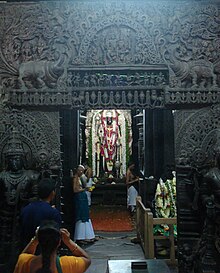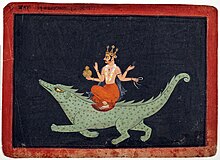Makara: Difference between revisions
→See also: +link |
+image |
||
| Line 1: | Line 1: | ||
[[ |
[[File:Belur Vishnu.jpg|thumb|Makara and [[Kirtimukha]] protecting portal to [[Garbhagriha]] and [[Vishnu]] icon of [[Chennakesava Temple]] at [[Belur]], [[Karnataka]]]] |
||
| ⚫ | According to [[Hindu mythology]], '''Makara''', a mythical creature, is the [[vahana]] of [[Ganga in Hinduism|Ganga]] and [[Varuna]]. It is also the insignia of [[Kamadeva]], a god representing love and lust. Kama’s flag (dhwaja) is known as Karkadhvaja, that is, a flag having makara depicted on the flag. It is the [[astrology|astrological]] sign of [[Capricorn (astrology)|Capricorn]], one of the twelve symbols of the [[Zodiac]]. They are often portrayed protecting entryways to Hindu and Buddhist temples. |
||
| ⚫ | According to [[Hindu mythology]], '''Makara''', a mythical creature, is the [[vahana]] of [[Ganga in Hinduism|Ganga]] and [[Varuna]]. It is also the insignia of [[Kamadeva]], a god representing love and lust. Kama’s flag (dhwaja) is known as Karkadhvaja, that is, a flag having makara depicted on the flag. It is the [[astrology|astrological]] sign of [[Capricorn (astrology)|Capricorn]], one of the twelve symbols of the [[Zodiac]]. |
||
==Etymology== |
==Etymology== |
||
[[Image:Ganga.jpg|thumb|Makara as the [[Vahana]] (vehicle) of the [[Ganges in Hinduism|goddess Ganga]]]] |
|||
[[File:Varunadeva.jpg|thumb|Makara as vehicle of [[Varuna]][[Deva (Hinduism)|deva]]]] |
[[File:Varunadeva.jpg|thumb|Makara as vehicle of [[Varuna]][[Deva (Hinduism)|deva]]]] |
||
Makara means ‘sea monster’ in [[Sanskrit]]<ref name="Sanskrit"> |
Makara means ‘sea monster’ in [[Sanskrit]]<ref name="Sanskrit"> |
||
| Line 42: | Line 42: | ||
==Iconography== |
==Iconography== |
||
| ⚫ | |||
Traditionally, a makara is considered to be an aquatic creature. Some traditional accounts identify it with a [[crocodile]], specifically [[Gharial]] because of its long extended snout. Other accounts identify it with [[Gangetic dolphin|Gangetic Dolphin]]having striking resemblances with the latter, now found mainly in [[Vikramshila Gangetic Dolphin Sanctuary]]. Others portray it as a fish body with an elephant's head. The tradition identifies the makara with water, the source of all existence and fertility.<ref name="Lenin"/> |
Traditionally, a makara is considered to be an aquatic creature. Some traditional accounts identify it with a [[crocodile]], specifically [[Gharial]] because of its long extended snout. Other accounts identify it with [[Gangetic dolphin|Gangetic Dolphin]]having striking resemblances with the latter, now found mainly in [[Vikramshila Gangetic Dolphin Sanctuary]]. Others portray it as a fish body with an elephant's head. The tradition identifies the makara with water, the source of all existence and fertility.<ref name="Lenin"/> |
||
| Line 58: | Line 57: | ||
|accessdate=2011-1-14 |
|accessdate=2011-1-14 |
||
|}}</ref> |
|}}</ref> |
||
| ⚫ | |||
[[File:Karava Makara flag.jpg|thumb|[[Karava Heraldry|Karava Makara flag]] from [[Sri Lanka]]]] |
[[File:Karava Makara flag.jpg|thumb|[[Karava Heraldry|Karava Makara flag]] from [[Sri Lanka]]]] |
||
Most importantly in a temple, the Makara serves as the structural [[bookend]]s of a thoranam or archway |
Most importantly in a temple, the Makara serves as the structural [[bookend]]s of a thoranam or archway around a deity. The arch emerges up from the jaws of one Makara, rises to it's peak, the [[Kirtimukha]] (the ‘Face of Glory'), and descends into the gaping jaws of another Makara. |
||
Makaras are a characteristic motif of the religious [[Khmer architecture]] of the [[Angkor]] region of [[Cambodia]] which was the capital of the [[Khmer Empire]]. Makaras are usually part of the decorative carving on a lintel, tympanum, or wall. Makaras are usually depicted with another symbolic animal, such as a lion, naga or serpent, emerging from its gaping open mouth. Makara are a central design motif in the beautiful lintels of the [[Hariharalaya|Roluos]] group of temples: [[Preah Ko]], [[Bakong]], and [[Lolei]]. At [[Banteay Srei]], carvings of makaras disgorging other monsters were installed on many of the buildings' corners. |
Makaras are a characteristic motif of the religious [[Khmer architecture]] of the [[Angkor]] region of [[Cambodia]] which was the capital of the [[Khmer Empire]]. Makaras are usually part of the decorative carving on a lintel, tympanum, or wall. Makaras are usually depicted with another symbolic animal, such as a lion, naga or serpent, emerging from its gaping open mouth. Makara are a central design motif in the beautiful lintels of the [[Hariharalaya|Roluos]] group of temples: [[Preah Ko]], [[Bakong]], and [[Lolei]]. At [[Banteay Srei]], carvings of makaras disgorging other monsters were installed on many of the buildings' corners. |
||
Revision as of 21:02, 15 January 2011

According to Hindu mythology, Makara, a mythical creature, is the vahana of Ganga and Varuna. It is also the insignia of Kamadeva, a god representing love and lust. Kama’s flag (dhwaja) is known as Karkadhvaja, that is, a flag having makara depicted on the flag. It is the astrological sign of Capricorn, one of the twelve symbols of the Zodiac. They are often portrayed protecting entryways to Hindu and Buddhist temples.
Etymology


Makara means ‘sea monster’ in Sanskrit[1], and is the origin of the word ‘mugger’ ( गुंडा ) in Hindi. [2] The Hindi word for Crocodile is मकर (makar, makara).[3] The English word 'mugger' evolved meaning one who sneaks up and attacks another. The name is applied to the Mugger crocodile, the most common crocodile in India, and is descriptive of it's aggressive feeding behavior.[4]
Iconography
Traditionally, a makara is considered to be an aquatic creature. Some traditional accounts identify it with a crocodile, specifically Gharial because of its long extended snout. Other accounts identify it with Gangetic Dolphinhaving striking resemblances with the latter, now found mainly in Vikramshila Gangetic Dolphin Sanctuary. Others portray it as a fish body with an elephant's head. The tradition identifies the makara with water, the source of all existence and fertility.[4]
The leading Hindu temple architect and builder Ganapati Sthapati describes Makara as a mythical animal with the body of a fish, trunk of an elephant, feet of a lion, eyes of a monkey, ears of a pig, and the tail of a peacock. These elements are variously joined to form one of the most common recurring themes in Indian temple iconography. In Indian art, the makara finds expression in the form of many motifs, and has been portrayed in different styles. Makara figures are placed on the entry points (Toranas) of several Buddhist monuments, including the stupa of Sanchi, a world heritage site. It is found guarding the entrances to royal thrones (see Distribution below).
In Hindu iconography, Makara is represented as the vahana (‘vehicle’) of Ganga, the river goddess. A row of Makara may run along the wall of a Hindu temple, or form the hand rail of a staircase. [4]


Most importantly in a temple, the Makara serves as the structural bookends of a thoranam or archway around a deity. The arch emerges up from the jaws of one Makara, rises to it's peak, the Kirtimukha (the ‘Face of Glory'), and descends into the gaping jaws of another Makara.
Makaras are a characteristic motif of the religious Khmer architecture of the Angkor region of Cambodia which was the capital of the Khmer Empire. Makaras are usually part of the decorative carving on a lintel, tympanum, or wall. Makaras are usually depicted with another symbolic animal, such as a lion, naga or serpent, emerging from its gaping open mouth. Makara are a central design motif in the beautiful lintels of the Roluos group of temples: Preah Ko, Bakong, and Lolei. At Banteay Srei, carvings of makaras disgorging other monsters were installed on many of the buildings' corners.
Chöd is a Tibetan Buddhist spiritual practice that incorporates the Makara into its iconography.
Distribution
Stone sculptures of the mythological Makara and its ancient place in the iconography in Hinduism and Buddhism are widely spread throughout South Asia and Southeast Asia. A few examples are shown below:
- Makara sculptures throughout South Asia and Southeast Asia
-
Makara from Northern Qi Dynasty (CE 550-577), China
-
Makara from Mathura, Uttar pradesh, India
-
Makara sculptures at the Candi Kalasan Temple, Indonesia
Cryptozoology
Some cryptozoologists suspect the legend of the Makara may be based in fact, and associate it with the Trunko sighting on South Africa's Indian coast.[5] Some ancient sketches of Makara do tend to resemble modern illustrated renditions of the prehistoric mammal Ambulocetus.
See also
- Free photo of Makara at Belur, Karnataka
- Photo fine Makara toranam in South India
- Photos of Tibetan Buddhist Makara
- Photos of Makara toranam at Bhoologanathar - Chozhamahadevi temples in Tiruchirappalli , Tamil Nadu, South India
References
- ^
Sir Monier Monier-Williams (2005), A Sanskrit-English dictionary: etymologically and philologically arranged, Motilal Banarsidass Publications, p. 771, retrieved 2011-1-14
{{citation}}: Check date values in:|accessdate=(help); Cite has empty unknown parameter:|1=(help) - ^
"Mugger", Raftar English - Hindi Dictionary, retrieved 2011-1-14
{{citation}}: Check date values in:|accessdate=(help); Cite has empty unknown parameter:|1=(help); line feed character in|work=at position 8 (help) - ^
"Crocodile", Raftar English - Hindi Dictionary, retrieved 2011-1-14
{{citation}}: Check date values in:|accessdate=(help); Cite has empty unknown parameter:|1=(help); line feed character in|work=at position 8 (help) - ^ a b c
Janaki Lenin (2011-1-14), "My Husband and Other Animals - The beast within", The Hindu, ARTS » HISTORY & CULTURE, Kasturi & Sons Ltd, retrieved 2011-1-14
{{citation}}: Check date values in:|accessdate=and|date=(help); Cite has empty unknown parameter:|1=(help); line feed character in|work=at position 12 (help) - ^
""Trunko"", AmericanMonsters., retrieved 2008-12-3
{{citation}}: Check date values in:|accessdate=(help); Cite has empty unknown parameter:|1=(help)
- Dictionary of Hindu Lore and Legend (ISBN 0-500-51088-1) by Anna Dallapiccola
- The Illustrated Book of Signs and Symbols by Miranda Bruce-Mitford
External links
![]() Media related to Makara at Wikimedia Commons
Media related to Makara at Wikimedia Commons









